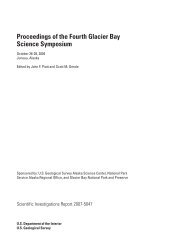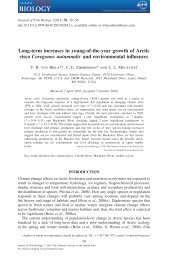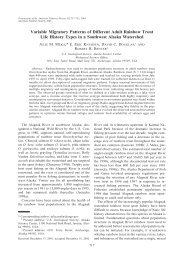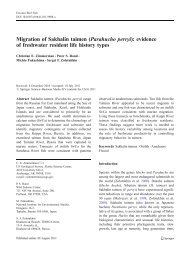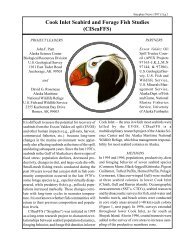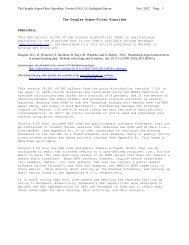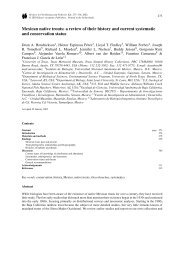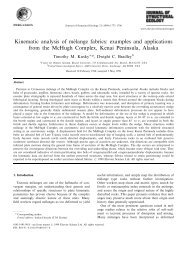Kline, T. C., C. A. Woody, M. A. Bishop, S. P. Powers, and E. E. ...
Kline, T. C., C. A. Woody, M. A. Bishop, S. P. Powers, and E. E. ...
Kline, T. C., C. A. Woody, M. A. Bishop, S. P. Powers, and E. E. ...
Create successful ePaper yourself
Turn your PDF publications into a flip-book with our unique Google optimized e-Paper software.
KLINE ET AL.<br />
ly-determined primary producer<br />
terrestrial end member (TEM 1 ) <strong>and</strong><br />
the a prior primary producer<br />
marine end member (MEM 1 ) of<br />
7.0 0 / 00. Thus, MDN TL = (δ15N –<br />
TEM TL ) X (MEM TL – TEM TL )-1 for a<br />
given δ15N value of trophic level<br />
TL. Primary producer TL = 1. MDS<br />
was calculated using a similar mixing<br />
model, however, because it was<br />
assumed there were no trophic level<br />
effects, MDS was determined using<br />
a generic TEM (note lack of subscript)<br />
<strong>and</strong> a generic marine-end<br />
member (MEM) by the following:<br />
MDS = (δ34S – TEM) X (MEM –<br />
TEM)-1, for a given δ34S value.<br />
MEM <strong>and</strong> TEM were determined<br />
empirically from measurements of<br />
periphyton grown at sites with little<br />
to no salmon influence at time of<br />
incubation <strong>and</strong> sampling <strong>and</strong> adult<br />
salmon carcasses, respectively.<br />
Results <strong>and</strong> Discussion<br />
Collectively, the SIA of maturing<br />
salmon <strong>and</strong> SIA of periphyton provided<br />
a range of δ15N, δ34S, δ13C<br />
<strong>and</strong> δ13C’ values for DP <strong>and</strong> RP<br />
organic sources, respectively, with<br />
little overlap between them. These<br />
results provided the context for interpreting<br />
SIA analysis of juvenile salmon.<br />
Allochthonous, Marine Food Sources<br />
Salmon delivered to CRD terrestrial <strong>and</strong><br />
freshwater ecosystems N that was ~10–13 0 / 00<br />
15N-enriched relative to air (Figure 1), which<br />
was similar to previous observations (e.g.,<br />
<strong>Kline</strong> et al. 1993). Salmon δ34S <strong>and</strong> δ13C’ values<br />
of ~20 <strong>and</strong> –21 0 / 00 were both relatively<br />
34S- <strong>and</strong> 13C-enriched <strong>and</strong> as expected for a<br />
marine source, with a variability range of<br />
about 1 <strong>and</strong> 2 0 / 00, respectively. On average,<br />
Figure 1. Figure 1. Copper River adult sockeye salmon δ 34 S (upper panel),<br />
δ 15 N (middle panel), <strong>and</strong> δ 13 C’ (lower panel) data shown with st<strong>and</strong>ard<br />
error bars by year, system, <strong>and</strong> sex.<br />
lipid normalization increased δ13C values by<br />
0.1 0 / 00 (SD = 0.36).<br />
Interannual differences in all three isotopes<br />
were generally small, even if statistically<br />
significant. There were systematic<br />
species differences in δ15N <strong>and</strong> δ13C’ values of<br />
approximately 3 <strong>and</strong> 0.5 0 / 00, respectively. These<br />
data may reflect late marine life stage trophic<br />
level differences. Assuming a common primary<br />
producer reference <strong>and</strong> a trophic enrichment of<br />
3.4 0 / 00, the observed higher δ15N values of coho<br />
salmon relative to sockeye salmon would suggest<br />
that they feed almost a full trophic level<br />
56




